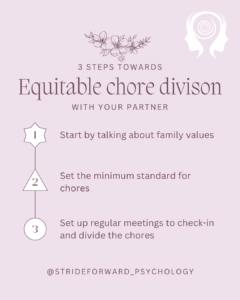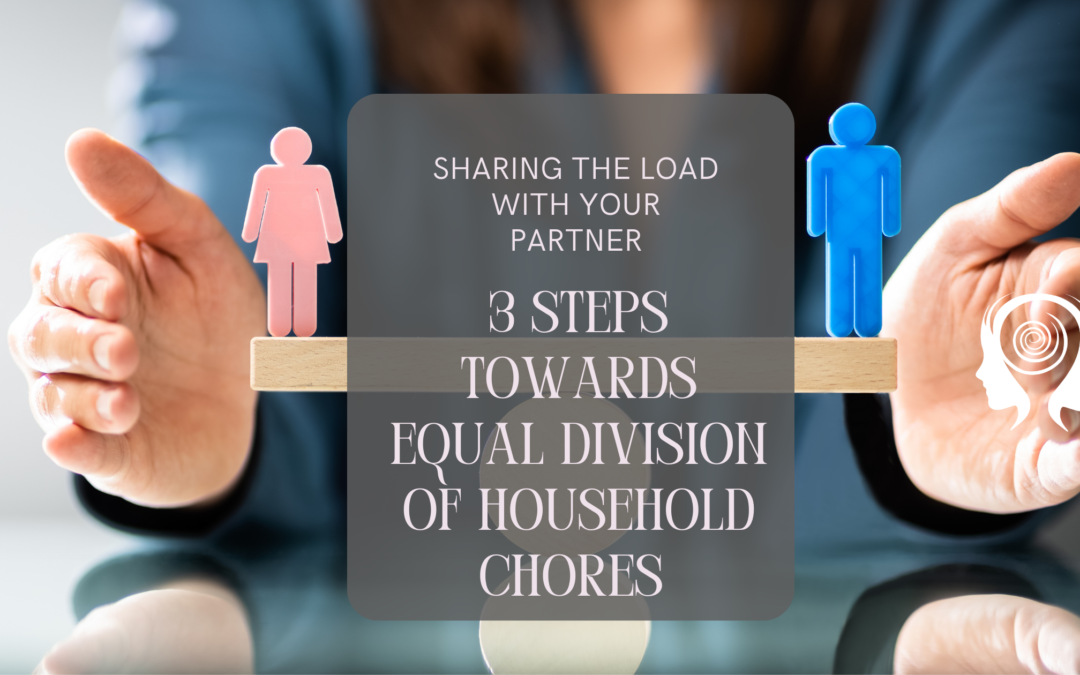Many couples struggle with dividing the household chores equally to make sure one person is not doing it all. This article can help you learn how to make equal household chore division possible!
With most of my postpartum clients, at one point during our work together, I find us talking about the load of motherhood. Mainly, how they feel resentful towards their partner as they are responsible for most of the household and child-related tasks.
Each time we start unpacking how the chores are divided, my blood starts to boil a little bit.
You see, I grew up in a household where no household task was categorized as for “men” or “women”. You could find my dad cleaning the floors or cooking dinner and mom painting the walls or mowing the lawn.
In my current relationship of almost 19 years, I’ve continued with a similar expectation. There are no gender-specific chores and the division of household chores needs to feel equitable.
So, sometimes it was hard for me to help my clients to take the FIRST steps towards sharing the load. That was until a few months ago when I finally read the book “Fair Play” by Eve Rodsky. After reading the book, I realized what I was missing when talking to my clients.
Now, I can provide my clients with a “road map” that will help them to share the load with their partner and get rid of the resentment.
These are the 3 simple steps towards dividing the household chores more equally:
1. Start by talking about the family values
Next time you have alone time with your partner, ask what is important for them and how that relates to your family unit. Do they value time spent outdoors, clean house and/or home-cooked meals? What holidays are important to them? What do they want for your children and for them to remember when they have their own families?
This will start the conversation about what needs to happen in order to live according to these values. For example, if both you and your partner value travel you can write down all that needs to happen in order to make a yearly beach vacation or a monthly road trip a reality.
Usually, this is not a one-and-done conversation. You can take a few weeks to further discuss what is important for both of you and list tasks related to the value.
2. Set the minimum standard for the chores
Hopefully, after focusing on values and getting clear about what is important for your family, you feel closer to your partner and like you are on the same page.
Now it’s time to pull out the task lists that you’ve been making and look at each task one by one. In addition, there might be some chores that didn’t get listed but you know that need to get done to keep the household functional. Add them to the pile.
What you want to do now is to set a minimum standard for each chore. As people are different, their expectations of how certain things need to get done will be different as well. If you get into an argument, think about what a reasonable person would consider as a minimum for the task at hand. You can even call a friend or family member.
To make sure you and your partner are on the same page you need to set the minimum standard. Either of you can always go the extra mile when doing a chore but neither of you can lower the standard when the task is their responsibility.
For example, the minimum standard for the chore “taking out the garbage” means that the full bags are replaced with new ones before they start overflowing and taken out before the next morning.
3. Set up weekly or bi-weekly meetings to check in and divide the chores
Now you and your partner know why things need to be done in your household (values) and what needs to happen in order to cross off the tasks (minimum standard).
The last step is to divide the chores. It doesn’t need to be a 50:50 division. The main thing is that it FEELS equitable. That is the end goal.
It will probably not feel fair right away, especially, if things have been really out of whack.
That is why the third step is setting up a weekly or bi-weekly time for a meeting. During your check-in meeting, you can share:
- How you felt about the load
- How you felt about the tasks you had
- Re-divide the chores
To make the meetings stick, add something fun or pleasurable to them. For example, a glass of wine, share a favorite treat or say 3 things that make you grateful for your partner. It also doesn’t have to happen at home but you can take the meetings outside or to a coffee shop or your favourite restaurant.

To recap, here are the three steps that are necessary (do not jump into sharing the tasks right away – 9 out of 10 it does not work!) to move towards more equal household chore division:
- Start by talking about your family values
- Set the minimum chore standard
- Set up weekly or bi-weekly meetings to check in and divide the tasks
If you feel resentful towards your partner because of the inequality in your household chore division, this is something I help people with. If you are interested in getting that help so you can build that equitable chore division, book a free 20-minute consultation!


